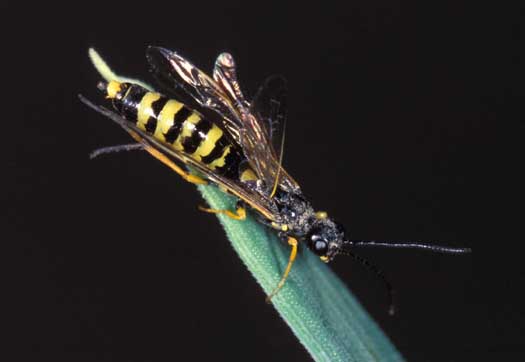
Female wheat stem sawfly
Sawflies are wasp-like insects. Adults are slender with a shiny black abdomen and yellow bands. Females have an ovipositor at the end of their abdomen, that allows them to saw into hollow-stemmed wheat to lay eggs. Larvae that develop inside wheat stems feed as they move to the base of the plant. Frass that is produced by feeding larvae forms a protective plug that provides shelter as they overwinter in stubble. The presence of the larvae causes bleaching of wheat heads, poor grain fill, stem lodging and shriveled kernals.
The wheat stem sawfly, Cephus cinctus (Hymenoptera: Cephidae), long a serious pest of wheat in the northern Great Plains, has begun to cause significant damage to winter wheat in Wyoming, eastern Colorado, and portions of Nebraska in the past couple of years. A long-time resident of Kansas, this pest has likely been laying eggs in wheat for many years, although its larvae have enjoyed little, if any, survival. This has been attributed to the phenology of winter wheat in Kansas which did not allow sufficient time for completion of larval development prior to crop maturity. Thus, sawfly populations in Kansas have largely been maintained through infestation of alternative hosts like wild Agropyron spp. This may be about to change, as an increasing proportion of larvae are surviving in wheat each year to emerge as adults in these neighboring regions. The full extent of range expansion by this fast-developing biotype is not yet known, but it is now confirmed present in northwest Kansas and along the Colorado border, although it has yet to reach levels of economic significance there. Mature sawfly larvae girdle the wheat stalk at its base, leading to lodging and significant crop losses. Incomplete development can pass unnoticed because girdling does not occur. When split, infested stalks contain a powdery frass that resembles fine sawdust. Wheat grains of infested plants may be shrivelled and seed weight and protein content reduced. Management is multifaceted and requires significant modification of cultural practices. Although adult dispersal appears to be limited, populations can explode quickly where wheat is grown continuously. Growers or crop consultants who suspect a sawfly infestation or collect suspect specimens should contact their local K-State Research and Extension agent or J.P. Michaud

